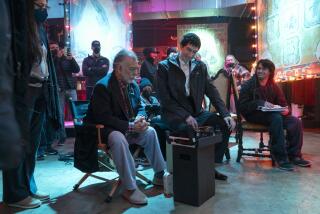Why did Disney’s ‘John Carter’ flop?
WhenWalt Disney Co.executives gave the greenlight to the project that became the Martian adventure film”John Carter,”they hoped they were launching the studio’s next big franchise.
It was to be directed by Andrew Stanton, who had been associated with a string of successful Pixar Animation Studios films — starting with the 1995 hit “Toy Story.” The source material was a century-old sci-fi touchstone that had inspired filmmakers including George Lucas and James Cameron. The movie would fit perfectly into Disney Chairman and Chief ExecutiveRobert A. Iger’s big-picture plan to produce movies that would spawn sequels, become theme park attractions and drive sales of “John Carter” merchandise.
Instead, with a weak opening this past weekend, Wall Street analysts expect the company to take a $165-million loss on a movie that has joined “Heaven’s Gate,” “Ishtar” and “Howard the Duck” in the constellation of Hollywood’s costliest flops.
What happened? The very things Disney thought would guarantee box-office success may have left “John Carter” star-crossed from the start. The acclaimed director had never made a live-action movie before. The executives guiding and helping market his movie were new on the job and had limited experience running movie divisions. And the source material, written beginning a century ago by Tarzan creator Edgar Rice Burroughs, had already been so picked over by its admirers that critics and audiences found the film hackneyed and stale.
Producer James Jacks, in fact, once took Burroughs’ Martian chronicles to filmmaker Robert Zemeckis, who’d made movie gold out of”Back to the Future” and other films. Zemeckis, a friend of”Star Wars” creator George Lucas, read the material and, Jacks says, told him, “I don’t think so. George has really plundered these books.”
Jacks worked with other filmmakers to get “Carter” into orbit for Paramount Pictures, finding willing partners in “Sin City’s” Robert Rodriguez, “Pan’s Labyrinth’s” Guillermo del Toro, “Sky Captain and the World of Tomorrow’s” Kerry Conran and “Iron Man’s” Jon Favreau — all of whom struggled to mold the dense stories into a workable script.
Paramount ultimately abandoned “John Carter” and allowed the rights to the material to expire. Even through Stanton was in the middle of production on “Wall-E,” he lobbied Walt Disney Studios Chairman Dick Cook to snap up the rights. Cook called Stanton two months later to say “John Carter” was his to direct. Stanton outlined the first three books, wrote a first draft of the script in 2007 and spent years working on the project in pre-production.
By the time “John Carter” started filming in January 2010, however, Cook had been replaced by Rich Ross, a television executive who had never overseen a film of this scope. Ross named as president of production Sean Bailey, a movie producer who lacked experience as a studio executive, then installed MT Carney, an outsider from the New York advertising world who’d never worked at a studio, as marketing chief. Then Carney left in early January and was replaced by veteran Ricky Strauss — just as the film’s promotional efforts were to kick into high gear.
“The worst thing that can happen to a movie is the marketing team changes midstream,” said Peter Sealey, marketing strategist and former marketing president at Columbia Pictures. “It’s disheartening for the filmmakers, for the talent. They lose belief in the film.”
Ross theoretically could have scuttled “John Carter” as he did with a planned $150-million production of “Captain Nemo: 20,000 Leagues Under the Sea.” Or stood firm and said “no” as he did to star Johnny Depp, who’d made a fortune for Disney starring in its “Pirates of the Caribbean” franchise, until costs were cut on his upcoming “The Lone Ranger.”
Instead, the studio stood behind Stanton, whose “Wall-E” and “Finding Nemo”brought in a combined $1.4 billion in worldwide box-office receipts and went on to collect Academy Awards for animated feature.
“It’s OK to swing for the fences and try to make a giant hit and establish a franchise. That is a worthy goal,” said Harold Vogel, a veteran media analyst and president of Vogel Capital Management. “But still, you’ve got to wonder how the budgets get so out of control.”
One industry veteran said the fundamental problem with “John Carter” had less to do with budget than with cognitive dissonance: The action plays out on Mars (known as Barsoom in the books and the film), a planet that contemporary audiences know is barren and uninhabited. That creates a formidable, elephant-in-the-room challenge for the movie’s marketers.
“You’re not able to sell that,” noted the industry insider, who asked not to be quoted commenting on someone else’s film.
Posters that at one point had been adorned with a mysterious figure under the letters “JC” were replaced by ads that featured a shirtless man fleeing giant white apes and left prospective moviegoers scratching their heads.
They have been confused, Sealey said: “What the hell is John Carter? What’s the film about? I don’t know who John Carter is. You’ve got to make that clear.”
“John Carter” still has the potential to earn some of its money back. The movie opened to just over $30 million in domestic box-office revenue and earned $70 million more worldwide — a pittance compared with the $600 million in global theatrical ticket sales that analysts have said the movie must generate just to break even.
But it’s not the “Star Wars” or “Star Trek”the studio was hoping, nor even the “Indiana Jones on Mars” that Stanton told Disney he hoped to make. The status of any “John Carter” sequels or theme park attractions is unclear.
“It’s not the first movie to cost a lot of money,” said former Fox Studios Chairman Bill Mechanic, speaking about his own experience with big-budget movies — among them the high-stakes winner “Titanic” and the high-stakes loser animated film “Titan A.E.” “With all the best intentions in the world — good script, great director, great cast — movies don’t always perform. Sometimes they’re just not interesting to the public.”
Times staff writer John Horn contributed to this report.
More to Read
The biggest entertainment stories
Get our big stories about Hollywood, film, television, music, arts, culture and more right in your inbox as soon as they publish.
You may occasionally receive promotional content from the Los Angeles Times.











